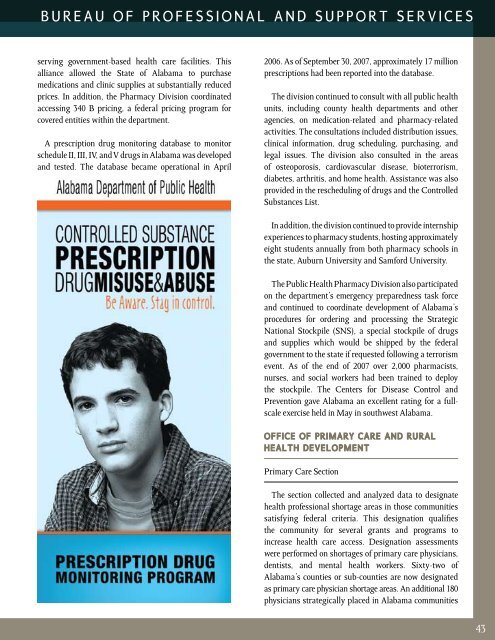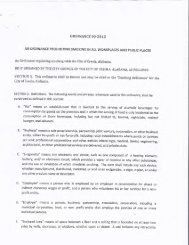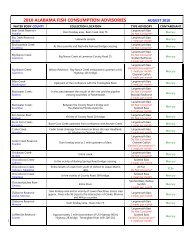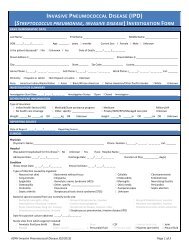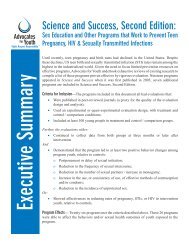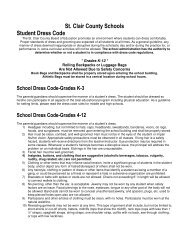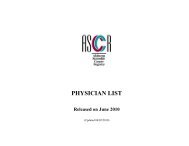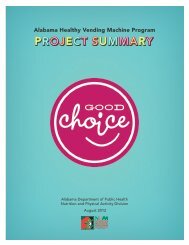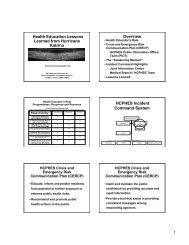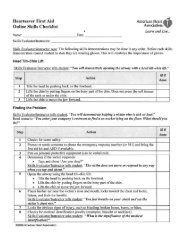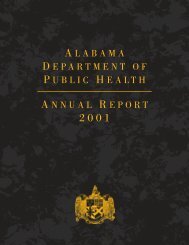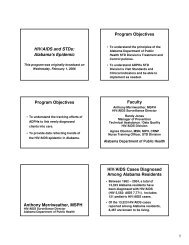2007 - Alabama Department of Public Health
2007 - Alabama Department of Public Health
2007 - Alabama Department of Public Health
Create successful ePaper yourself
Turn your PDF publications into a flip-book with our unique Google optimized e-Paper software.
ureau <strong>of</strong> pr<strong>of</strong>essional and support services<br />
serving government-based health care facilities. This<br />
alliance allowed the State <strong>of</strong> <strong>Alabama</strong> to purchase<br />
medications and clinic supplies at substantially reduced<br />
prices. In addition, the Pharmacy Division coordinated<br />
accessing 340 B pricing, a federal pricing program for<br />
covered entities within the department.<br />
A prescription drug monitoring database to monitor<br />
schedule II, III, IV, and V drugs in <strong>Alabama</strong> was developed<br />
and tested. The database became operational in April<br />
2006. As <strong>of</strong> September 30, <strong>2007</strong>, approximately 17 million<br />
prescriptions had been reported into the database.<br />
The division continued to consult with all public health<br />
units, including county health departments and other<br />
agencies, on medication-related and pharmacy-related<br />
activities. The consultations included distribution issues,<br />
clinical information, drug scheduling, purchasing, and<br />
legal issues. The division also consulted in the areas<br />
<strong>of</strong> osteoporosis, cardiovascular disease, bioterrorism,<br />
diabetes, arthritis, and home health. Assistance was also<br />
provided in the rescheduling <strong>of</strong> drugs and the Controlled<br />
Substances List.<br />
In addition, the division continued to provide internship<br />
experiences to pharmacy students, hosting approximately<br />
eight students annually from both pharmacy schools in<br />
the state, Auburn University and Samford University.<br />
The <strong>Public</strong> <strong>Health</strong> Pharmacy Division also participated<br />
on the department’s emergency preparedness task force<br />
and continued to coordinate development <strong>of</strong> <strong>Alabama</strong>’s<br />
procedures for ordering and processing the Strategic<br />
National Stockpile (SNS), a special stockpile <strong>of</strong> drugs<br />
and supplies which would be shipped by the federal<br />
government to the state if requested following a terrorism<br />
event. As <strong>of</strong> the end <strong>of</strong> <strong>2007</strong> over 2,000 pharmacists,<br />
nurses, and social workers had been trained to deploy<br />
the stockpile. The Centers for Disease Control and<br />
Prevention gave <strong>Alabama</strong> an excellent rating for a fullscale<br />
exercise held in May in southwest <strong>Alabama</strong>.<br />
Office <strong>of</strong> Primary Care and Rural<br />
<strong>Health</strong> Development<br />
Primary Care Section<br />
The section collected and analyzed data to designate<br />
health pr<strong>of</strong>essional shortage areas in those communities<br />
satisfying federal criteria. This designation qualifies<br />
the community for several grants and programs to<br />
increase health care access. Designation assessments<br />
were performed on shortages <strong>of</strong> primary care physicians,<br />
dentists, and mental health workers. Sixty-two <strong>of</strong><br />
<strong>Alabama</strong>’s counties or sub-counties are now designated<br />
as primary care physician shortage areas. An additional 180<br />
physicians strategically placed in <strong>Alabama</strong> communities<br />
43


